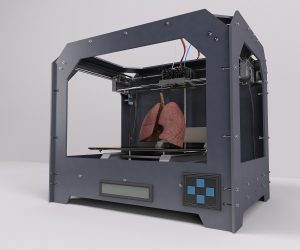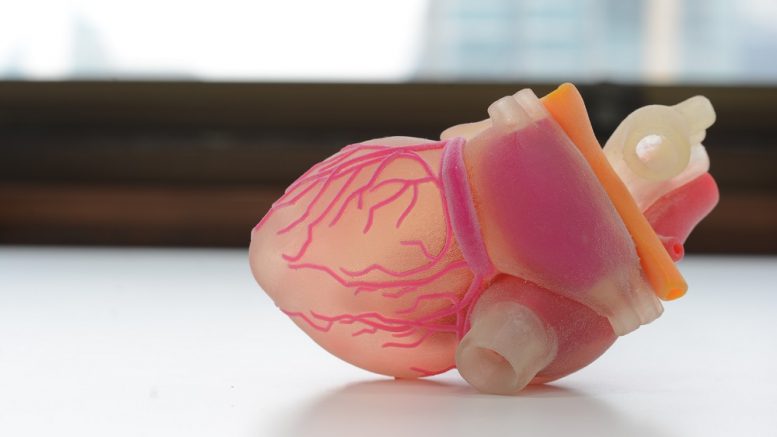3D printing, also known as additive manufacturing, is disrupting many industries. Besides offering endless possibilities to the manufacturing world, 3D printing is gaining popularity in the healthcare industry as well. In fact, the global 3D printing in healthcare market is expected to reach a value of $1.97 billion by 2023, with North America and the Asia-Pacific region as the major players in the industry. 3D printing technology has become more sophisticated, which represents a big opportunity for healthcare professionals, who can better plan their procedures and improve patient outcomes.
What’s even more exciting is using additive manufacturing to create 3D-printed organs. This could reduce organ transplant waiting lists and save hundreds of thousands of lives around the world. Though this technology will require more time to evolve, researchers and experts interested in the development of 3D-printed organs have already made significant progress.
Researchers 3D-printed a structure that behaves like human lungs
For instance, a team of bioengineers at the University of Washington and Rice University created a 3D-printed organ that mimics human lungs. They used an innovative open-source bioprinting technology called stereolithography apparatus for tissue engineering (SLATE). This method involves using a pre-hydrogel solution to print layers one at a time, and the structure solidifies once it’s exposed to blue light. Their research, published in Science Magazine, reveals how the scientists used SLATE to create a 3D-printed scale model of an air sac that functions like human lungs. “Ours is the first bioprinting technology that addresses the challenge of multi-vascularization in a direct and comprehensive way,” says Jordan Miller, the lead bioengineer from Rice University.
What makes their breakthrough even more interesting is that they added photoabsorbers to the solution, in the form of food dyes, to absorb blue light. These food additives, including anthocyanin, curcumin, and tartrazine, are non-toxic and safe. During testing, the 3D-printed structure was able to withstand normal blood pressure variations and simulated breathing movements. The team is optimistic about their discovery, and they believe it brings us closer to 3D printing ready-made organs for patients.

This 3D-printed heart is made from human tissue
Another breakthrough that could revolutionise organ transplant procedures comes from researchers at Tel Aviv University, who managed to 3D print a fully-functioning heart. This is a major advancement, because so far, scientists were only able to print simple tissues. This heart, in contrast, contains “blood vessels, chambers, cells, and more”, making it “the world’s first vascularized engineered heart”. It’s made from human cells and biological materials, and it’s currently the size of a rabbit’s heart, but the researchers plan to scale it up to a full-sized human heart in the future.
Before starting the 3D printing process, the scientists performed a biopsy on a patient’s fatty tissue to create a personalized hydrogel. Later, that hydrogel was used to form bioink for the 3D printing process. And using the patient’s own biomaterials to create the bioink reduces the risk of implant rejection, which can happen after patients receive organ transplants. In fact, up to 50% of all organ donations end up being rejected by the patient’s body within a decade.
Currently, the cells within the 3D-printed heart can contract, but they need to be able to pump, so that the heart can work properly. Still, the team from Tel Aviv University believes this method could become the standard. As Professor Tal Dvir, who led the research, explains, “Maybe, in ten years, there will be organ printers in the finest hospitals around the world, and these procedures will be conducted routinely.” With this breakthrough, researchers could solve the organ shortage crisis and save the lives of those waiting for a heart transplant.
A 3D-printed organs could be used to treat diabetes more effectively
A discovery made by researchers at the Foundation for Research and Science Development in Poland is also promising to save many lives. The team used 3D printing biotechnology to create a bionic pancreas that could be used in diabetes treatment.
The human pancreas plays an essential role in digestion. It’s surrounded with pancreatic islets, which are in charge of producing insulin and glucagon. In people suffering from diabetes, these pancreatic islets are damaged and aren’t able to produce these hormones, so some patients need to take insulin injections every couple of hours. But the researchers believe their innovation, once implanted into a patient, could restore insulin production and eliminate the need for traditional insulin therapy.
To develop the 3D-printed pancreas, the team used pancreatic islets from animals. The pancreatic islets were then mixed with bioink to ensure the survival of the 3D-printed cells. To print the organ, embedded with blood vessels, a special 3D bio-printer relied on a computer-assisted model. The scientists involved in the research are certain that their discovery is “a huge step towards curing diabetes”. The next stage of the research will be to make sure their breakthrough performs well on living organisms, so they’ll be testing a 3D-printed pancreas on mice and pigs throughout 2019.
Why is 3D printing poised to disrupt the future healthcare?
The waiting lists for organ transplants are getting longer, while the supply of organs isn’t increasing. Many people never get a chance to receive a life-saving organ, and even those who do are at risk of organ rejection. All these factors are forcing more scientists to consider and explore the potential of 3D printing as an alternative solution for patients waiting for a transplant. Using 3D printing techniques, hospitals could produce customized organs made from human cells, which could finally put an end to lengthy waiting lists and save people’s lives.
Author: Richard van Hooijdonk
International keynote speaker, trendwatcher and futurist Richard van Hooijdonk offers inspiring lectures on how technology impacts the way we live, work and do business. Over 420,000 people have already attended his renowned inspiration sessions, in the Netherlands as well as abroad. He works together with RTL television and presents the weekly radio program ‘Mindshift’ on BNR news radio. Van Hooijdonk is also a guest lecturer at Nyenrode and Erasmus Universities.
Sources
Aimar, Anna, Palermo, Augusto, and Bernardo Innocenti, https://www.hindawi.com/journals/jhe/2019/5340616/.
Business Wire, https://www.businesswire.com/news/home/20181212005326/en/3D-Printing-Global-Healthcare-Market-2018-2023-Expected.
Grossman, David, https://www.popularmechanics.com/science/health/a27355578/3d-print-lungs/.
Pycka, Marlena, https://www.thefirstnews.com/article/researchers-create-worlds-first-3d-bionic-pancreas-5156.
Stewart, Jessica, https://mymodernmet.com/3d-printed-heart/.
Tangermann, Victor, https://www.sciencealert.com/researchers-have-just-3d-printed-a-mini-heart-using-human-tissue.
Thomas, Liji, https://www.news-medical.net/news/20190503/Scientists-print-3D-structure-that-mimics-the-air-sacs-in-the-lungs.aspx.
Watkin, Hanna, https://all3dp.com/4/world-first-3d-printed-bionic-pancreas-one-day-treat-diabetes/.





